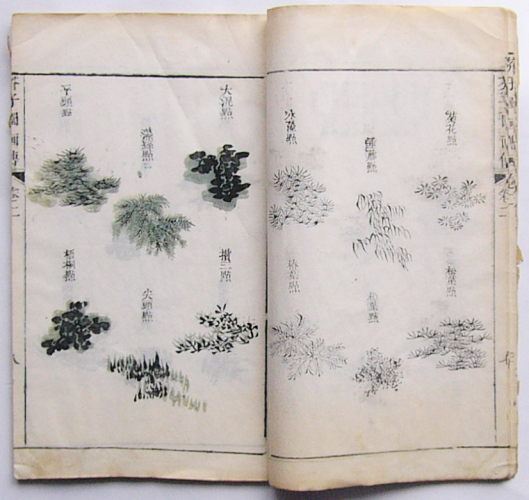Manual of the Mustard Seed Garden on:
[Wikipedia]
[Google]
[Amazon]
 ''Manual of the Mustard Seed Garden'' (, ), sometimes known as (), is a printed manual of
''Manual of the Mustard Seed Garden'' (, ), sometimes known as (), is a printed manual of  The volume also entered
The volume also entered
Mustard Seed Garden, a Chinese Painter's Manual
~ at Internet Archive.
/nowiki>]. Les Enseignements de la Peinture du Jardin grand comme un Grain de Moutarde. Encyclopédie de la peinture chinoise Traduction et commentaires par Raphaël PETRUCCI (1910), at les Classiques des sciences sociales, l'Université du Québec. {{Authority control Chinese painting Books about visual art Qing dynasty literature
Chinese painting
Chinese painting () is one of the oldest continuous artistic traditions in the world. Painting in the traditional style is known today in Chinese as ''guó huà'' (), meaning "national painting" or "native painting", as opposed to Western style ...
compiled during the early-Qing Dynasty
The Qing dynasty ( ), officially the Great Qing,, was a Manchu-led imperial dynasty of China and the last orthodox dynasty in Chinese history. It emerged from the Later Jin dynasty founded by the Jianzhou Jurchens, a Tungusic-speak ...
. Many renowned later Chinese painters, like Qi Baishi
Qi Baishi (1 January 1864 – 16 September 1957) was a Chinese painter, noted for the whimsical, often playful style of his works. Born to a peasant family from Xiangtan, Hunan, Qi taught himself to paint, sparked by the Manual of the Musta ...
, began their drawing lessons with the manual. It is an important early example of colour printing
Color printing or colour printing is the reproduction of an image or text in color (as opposed to simpler black and white
or monochrome printing). Any natural scene or color photograph can be optically and physiologically dissected into three ...
.
The work was commissioned by Shen Xinyou (), son-in-law of the famous playwright Li Yu, whose mansion in Lanxi, Zhejiang
Zhejiang ( or , ; , also romanized as Chekiang) is an eastern, coastal province of the People's Republic of China. Its capital and largest city is Hangzhou, and other notable cities include Ningbo and Wenzhou. Zhejiang is bordered by Ji ...
province was known as Jieziyuan, or Mustard Seed Garden. Shen possessed the teaching materials of Li Liufang (李流芳), a painter of the late-Ming dynasty
The Ming dynasty (), officially the Great Ming, was an Dynasties in Chinese history, imperial dynasty of China, ruling from 1368 to 1644 following the collapse of the Mongol Empire, Mongol-led Yuan dynasty. The Ming dynasty was the last ort ...
, and commissioned Wáng Gài (), Wáng Shī (), Wáng Niè () and Zhū Shēng () to edit and expand those materials with the aim of producing a manual for landscape painting. The result was the first part of , which, published in 1679 in five colours, comprises five () or fascicles. Li Yu, as the publisher, wrote a preface for this part. The first fascicle deals with the general principles of landscape painting, the second the painting of trees, the third that of hills and stones, the fourth that of people and houses, and the fifth comprises the selected works of great landscape painters.
 The volume also entered
The volume also entered Edo period
The or is the period between 1603 and 1867 in the history of Japan, when Japan was under the rule of the Tokugawa shogunate and the country's 300 regional '' daimyo''. Emerging from the chaos of the Sengoku period, the Edo period was character ...
Japan, where woodblock printed
Woodblock printing or block printing is a technique for printing text, images or patterns used widely throughout East Asia and originating in China in antiquity as a method of printing on textiles and later paper. Each page or image is create ...
copies became relatively easily accessible in all the major cities; the ''Mustard Seed Garden Manual'' came to be used by a great many Japanese artists and was a major element in the training of artists and the development of Edo period painting.
Two more parts, which deal with the painting of flora and fauna, were produced by Wang and his two brothers and published 1701. Shen promised a fourth part, but never published it. A fourth part, which deals with portraits, was produced by some quick profit-seeking publisher, though. Chao Xun () (1852–1917), dissatisfied with the fake, produced his own sequel, as well as carefully reproduced the first three volumes. Reprints of the first three volumes are usually based on Chao's reproduction.
An English translation of the work, ''The Tao of Painting – A study of the ritual disposition of Chinese painting. With a translation of the Chieh Tzu Yuan Hua Chuan or Mustard Seed Garden Manual of Painting 1679–1701'', was made by Mai-mai Sze
Yuen Tsung Sze (December 2, 1909 – July 16, 1992), known professionally as Mai-mai Sze, was a Chinese-American painter and writer. The Bollingen Foundation first published her translation of the '' Jieziyuan Huazhuan'' or ''The Mustard Seed Gar ...
and published in New York in 1956.
References
*'' Zhongguo da baike quanshu''. First Edition. Beijing; Shanghai: Zhongguo da baike quanshu chubanshe. 1980–1993.External links
Mustard Seed Garden, a Chinese Painter's Manual
~ at Internet Archive.
/nowiki>]. Les Enseignements de la Peinture du Jardin grand comme un Grain de Moutarde. Encyclopédie de la peinture chinoise Traduction et commentaires par Raphaël PETRUCCI (1910), at les Classiques des sciences sociales, l'Université du Québec. {{Authority control Chinese painting Books about visual art Qing dynasty literature